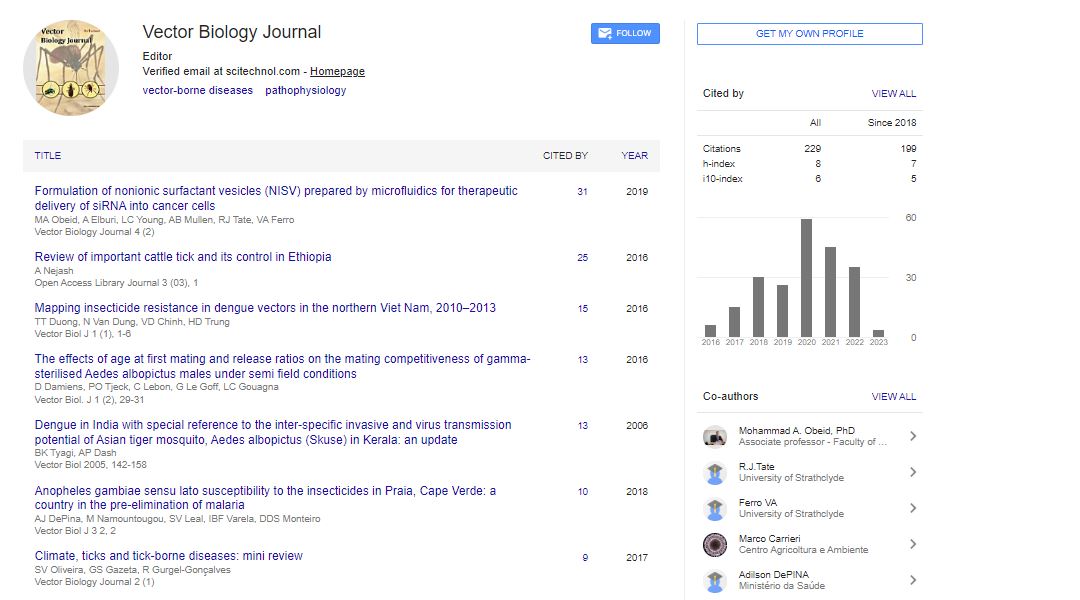Perspective, Vector Biol J Vol: 8 Issue: 4
Dengue Fever: Prevention, and Management of Global Difficulties
Oliveira Ralphi*
1Department of Biology, Federal University of Maranhao, Maranhao, Brazil
*Corresponding Author: Oliveira Ralphi,
Department of Biology, Federal
University of Maranhao, Maranhao, Brazil
E-mail: ralphi.oli@gmail.com
Received date: 21 November, 2023, Manuscript No. VBJ-24-127797;
Editor assigned date: 23 November, 2023, PreQC No. VBJ-24-127797 (PQ);
Reviewed date: 07 December, 2023, QC No. VBJ-24-127797;
Revised date: 15 December, 2023, Manuscript No. VBJ-24-127797 (R);
Published date: 22 December, 2023, DOI: 10.4172/2473-4810.1000274.
Citation: Ralphi O (2023) Dengue Fever: Prevention, and Management of Global Difficulties. Vector Biol J 8:4.
Description
Dengue fever, a mosquito-borne viral illness, poses a significant public health challenge in many regions of the world, particularly in tropical and subtropical regions. It is Characterized by high fever, severe joint and muscle pain, headache, rash, and in severe cases, hemorrhagic manifestations, dengue fever is caused by the dengue virus, transmitted primarily by the Aedes aegypti and, to a lesser extent, Aedes albopictus mosquitoes. With no specific treatment or vaccine available, prevention and control methods plays an important role in mitigating the impact of this disease on affected populations.
The epidemiology of dengue fever has witnessed a dramatic increase in recent decades, with the incidence of dengue cases rising rapidly across endemic regions. Factors such as urbanization, population growth, inadequate sanitation, and climate change have contributed to the proliferation of Aedes mosquito populations and the spread of dengue virus transmission. As a result, dengue fever has become a significant burden on healthcare systems and a threat to global health security.
Preventing dengue transmission relies primarily on vector control measures and community engagement. The removal of mosquito breeding sites, such as stagnant water containers and discarded tires, it is essential for reducing mosquito populations and preventing the spread of the virus. Insecticide spraying, larvicide treatment, and the use of mosquito nets and screens also contribute to vector control efforts. Additionally, public awareness campaigns aimed at developing community’s participation in mosquito control and personal protection measures, such as wearing long-sleeved clothing and using insect repellents, are integral components of dengue prevention techniques.
Despite these efforts, dengue fever remains a significant public health concern, with an estimated 390 million infections occurring yearly, around the world. The absence of specific antiviral medications or vaccines for dengue provides challenges for disease management and control. Symptomatic treatment focused on relieving pain and fever is the foundation of clinical care for dengue patients. However, in severe cases of dengue hemorrhagic fever and dengue shock syndrome, early detection and supportive care are essential for reducing mortality rates.
The development of a safe and effective dengue vaccine represents an ensuring method to dengue prevention. Dengvaxia, the first licensed dengue vaccine, has shown varying degrees of efficacy in clinical trials and it is approved for use in several endemic countries. However, it is concerned about vaccine safety, particularly in individuals who are not currently exposed to dengue, have resulted in careful evaluation of immunization techniques and populations to be targeted.
In addition to biomedical interventions, addressing the social and environmental determinants of dengue transmission is essential for sustainable control efforts. Poverty, inadequate housing, and limited access to healthcare contribute to the vulnerability of communities to dengue fever. Urban planning initiatives aimed at improving sanitation, water management, and housing conditions can help to reduce mosquito breeding sites and minimize the risk of dengue transmission in endemic areas.
International collaboration is essential for advancing the understanding of dengue fever and developing innovative techniques for its prevention and control. Initiatives such as the World Health Organization's Global method for dengue prevention and control and the dengue vaccine initiative play essential roles in coordinating Scientific efforts, increasing vaccine development, and supporting dengue control programs in endemic countries.
Dengue fever remains a significant global health hazards that requires comprehensive and integrated methods for effective prevention and management. By addressing the social, environmental, and biomedical dimensions of dengue transmission.
 Spanish
Spanish  Chinese
Chinese  Russian
Russian  German
German  French
French  Japanese
Japanese  Portuguese
Portuguese  Hindi
Hindi 